Problem solving in deepest Norway
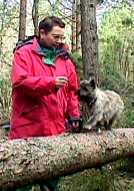 Mike and Else Theiss live in beautiful southwestern Norway with their two Cairn Terriers and a
Flat-coated Retriever. They say that most of the top Norweigan teams come from the east, and
their area is considered a 'white spot' on the agility map. Because they live so far out in the
country, they don't have the possibility of participating in organized agility training on a
regular basis, so they had to find 'alternatives.'
Mike and Else Theiss live in beautiful southwestern Norway with their two Cairn Terriers and a
Flat-coated Retriever. They say that most of the top Norweigan teams come from the east, and
their area is considered a 'white spot' on the agility map. Because they live so far out in the
country, they don't have the possibility of participating in organized agility training on a
regular basis, so they had to find 'alternatives.'
Competitions are not yet our first priority. We take our
time thinking of ways to ensure a positive approach in learning the different obstacles, and
want to let the dogs experience success each time we make them try.
Mike and Else say they are not very
familiar with technical terms for agility in the English language so rather than writing a lot
of text, they use photos to illustrate their message. By showing how they perform agility
training with their dogs Blueberry Hill, Penny Lane and Laura. They hope that other people
whether they be beginners or more experienced handlers will get some ideas that will be useful
for their own training.
Communication, Education & Positive Activities
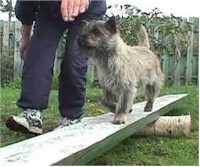 The
See-saw The
See-saw
Untrained dogs feel uncomfortable when they walk on the teeter (see-saw). The narrow path, the
height and the fact that this obstacle is tilting makes them feel unsafe. We solve this problem
by using very low teeters in the start, and we concentrate on the tilting process.
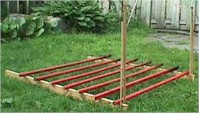 The Long Jump
The Long Jump
This is how we can make our own equipment for the Long Jump using two wooden boards, thin poles
to keep those boards up-right, and our broomstick-poles from the Weave Pole equipment. At the
beginning, small breeds like Cairn Terriers perform better than the bigger ones.
 The
A-frame The
A-frame
Speed is what one needs to get over the high and steep A-Frame, prevent sliding down backwards
or having to perform push-ups to get to the top. A skeptical or unwilling dog, however, will
not speed up for other reasons than escape.
We recommend that you begin by running up slopes and
outdoor stairways together with your dog. Use the same signals and commands as if you were at
the A-Frame. Treat the dog the same way as if he had delivered a great performance. Try to make
the dog run in front of you. After all, this is what you would like him to do later on agility
courses.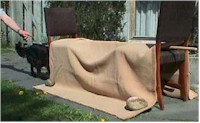
The Tunnel
No problem. Two chairs, a broomstick and a blanket. This can even be done in your living room.
The Dogwalk
We often encourage our dogs to balance, which originally was a natural ability for their
forefathers.

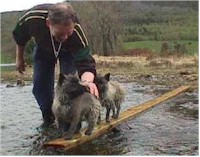
Photo credits: © Mike & Else Theiss from their web site
http://www.uio.no/~theiss/toensb.html.
For more information about their
training techniques, email them on:-
http://www.uio.no/~theiss/agilitye.html
|